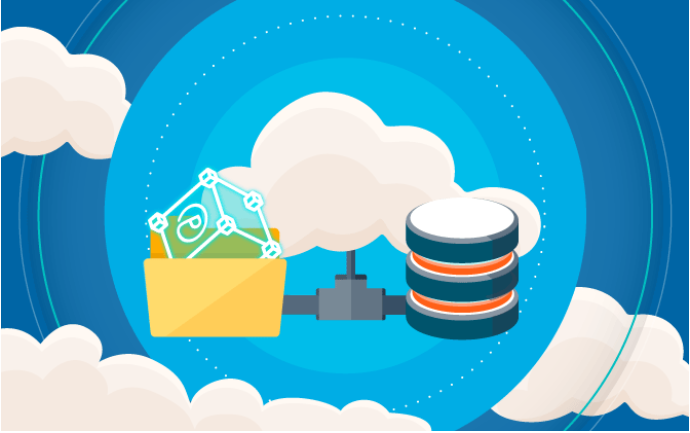
What is cloud computing? A beginner’s guide
Everything you need to know about the on-demand delivery of computing services.

What will we see in this post
Unless you’ve been living in a cave for the last few years, you have certainly heard of cloud computing. But do you know what this term really means?
Nowadays, it is increasingly common to find tools that use this technology, whether for data storage or to allow access to services and features.
If you still don’t fully understand cloud computing, or want to learn more about the subject, this article will teach you everything you need to know. Keep reading!
Check out what you’ll be learning:
What is cloud computing?
Cloud computing is the technology that allows you to access content and carry out tasks on the internet without having to install applications on your computer or mobile device.
The storage and access of data is done on a network. This means that you simply connect a device online in order to use all the available features and tools.
All information and files are stored on the internet (the cloud). Thus, you or any other person can access it whenever or wherever, without having to download and install anything. All you need is an internet connection.
Without being aware of it, every day you are in contact with services that use cloud computing technology. If you have ever created a document on Google Docs, watched a video on YouTube or listened to music on Spotify, you have used cloud computing.
In order to use these online services, you don’t have to download and install anything (except for smartphone apps, but that’s another story). You just need your browser and an internet connection to access all of the features.
What are the main uses of cloud computing?
It is relatively new. The first cloud services appeared in the late 1990s, when the internet wasn’t as popular as it is today.
Since then, a lot has changed and cloud services are everywhere. You are only reading this article now because of cloud computing!
Check out a few examples of what can be done with cloud services:
Store and backup data
With a cloud service, you can protect data and files more efficiently. Cloud computing allows you to transfer this information to remote servers. This allows users to access this data whenever and wherever they want by using any device connected to the internet.
Stream audio and video content
The cloud also allows you to offer audio and video streaming services. Simply store these files on a remote server so that the public can access them without downloading.
Analyze information
One of the major challenges faced by many businesses is being able to integrate information from all departments in order to facilitate the data analysis process.
Cloud computing technology allows the unification of data from different teams and locations in a single place. Thus, this makes it easier to use smart services to have insights and make decisions that are more informed.
Provide software and on-demand service
One way of democratizing access to a brand’s services is through the cloud. The on-demand software model has gained space, allowing users to use the latest versions of programs whenever they need to, without having to download and install anything on their devices.
What are the benefits of cloud computing?
It represents a huge transformation in how we think about accessing information and provides many benefits for users.
Below, you will find a few reasons that explain the increasing number of users and organizations who have adopted cloud computing:
Less expenses
This is one of the first issues on the mind of those thinking about hiring a cloud service.
With the release of new software versions and updates, you usually need to buy new hardware in order to take advantage of all of its features.
With cloud computing, on the other hand, this expense is no longer necessary.
Since all features and information are stored remotely and can be accessed from any device, eliminating compatibility issues.
Time saving
With traditional computing, acquiring and expanding basic services, such as storage space, requires planning and waiting time until the features are ready to be used.
With cloud computing, on the other hand, new features can be acquired and used instantly. With one click, you gain more storage space or release advanced software features.
Increased productivity
Having a local datacenter requires a variety of equipment and processes. It is necessary to configure the hardware, install and update software, among other tasks that consume time and resources.
By adopting cloud computing, all of these tasks are undertaken by the cloud service. Thus, your business can invest in other areas, increasing overall productivity.
Better performance
Cloud computing services use a network of secure data centers, with regularly updated hardware.
This ensures many benefits, such as lower network latency for the use of applications, in addition to the guaranteed access to the latest hardware technologies on the market.
Reliability and security
Most cloud computing providers work with policies, technologies and controls that ensure the security and protection of the data, applications and infrastructure against possible threats.
In addition, cloud computing facilitates data backup and recovery, which can be mirrored across multiple servers on the network and accessed at any time.
How does cloud computing work?
In cloud computing, a remote server is used to connect several different devices to unified features and services.
This server stores data and programs, which can be accessed by users from anywhere in the world, provided that they have an internet connection.
There are 3 types of cloud computing, each one with different features and objectives: public, private and hybrid cloud. If you intend to invest in this type of technology for your business, it is important to know all of them.
Public cloud
These are servers and storage services provided by third parties, which are available so that anyone, either users or companies, can hire them.
In public cloud computing, users are responsible for the content that will be uploaded to the server, as a file backup or an application. On the other hand, the cloud provider ensures the maintenance and security of all resources.
Services such as Google Drive and Dropbox are popular examples of public cloud computing.
Private cloud
In the private cloud model, a company maintains the entire server infrastructure in its domain, and offers restricted access to only a few users selected as partners and collaborators.
Because the private cloud is designed for the exclusive use of the company, all features and resources are geared towards the business’ needs. This ensures a more personalized experience in comparison with the public cloud.
Hybrid cloud
As the name suggests, hybrid cloud computing combines the operation and features of the previous models. Thus, it allows the sharing of data and applications between both types of cloud.
In this manner, depending on the user’s needs, it’s possible to use resources privately or publicly, offering greater flexibility.
Types of cloud services
Practically all cloud-computing services can be classified into four broad categories, IaaS, PaaS, serverless computing and SaaS.
Below, you can check out a bit more about each one:
IaaS (Infrastructure as a Service)
IaaS is the most basic type of cloud service. With it, users rent the entire IT infrastructure – servers and virtual machines, storage, networks and operational systems -, from a provider and pay according to use.
PaaS (Platform as a Service)
In this cloud model, users hire an on-demand development environment, where they can create, change and optimize software applications.
PaaS allows developers to create applications quickly, without the need to configure or manage the necessary infrastructure.
Serverless computing
Like PaaS, serverless computing is geared towards the creation of applications without the need to manage servers and infrastructure.
The cloud provider handles the configurations, planning, and management of the necessary servers and resources.
SaaS (Software as a Service)
SaaS, on the other hand, allows users to access software without having to download and install data on their devices. It is usually based on a subscription model, where users pay for the resources they need.
In this model, providers host and manage the application and the entire infrastructure required for its use, including regular updates and maintenance.
Conclusion
As you could see, cloud computing is already part of your daily life. And there’s a tendency that increasingly more services will be offered based on this model.
Technological innovations and the popularization of smartphones allow people to be constantly connected to the internet. Therefore, it is increasingly important to be able to access services and features remotely, from any device.
Now that you know what cloud computing is and how it works, take the opportunity to learn more about the universe of information technology and learn how to bring Big Data to your business.





